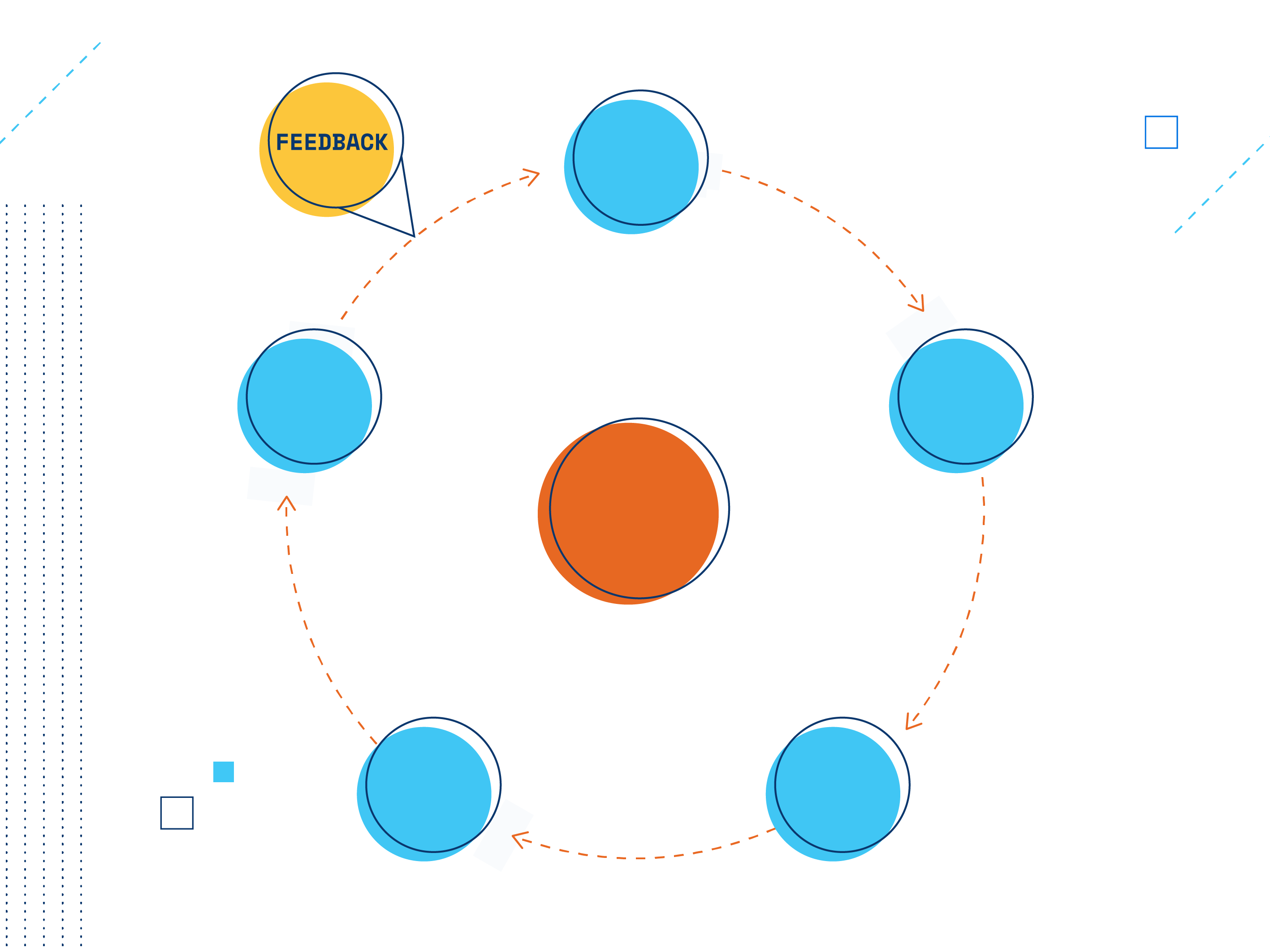Enhancing the Intelligence Cycle: How to Leverage Feedback to Provide More Valuable Intelligence
Learn why intelligence feedback is so important and uncover strategies for getting the insights you need

“The best intelligence goes to the best clients.” This statement by Paul Kolbe, former CIA Senior Executive and former BP Head of Intelligence, has resonated for years in the corporate intelligence community. If you’re on a private sector intelligence team, delivering useful intelligence to your clients (or consumers of your intelligence deliverables) starts with fostering a relationship with those clients that’s grounded in mutual trust and feedback.
However, when I speak with contacts across our community, it’s clear that getting feedback is a common challenge. I have also noticed that feedback is rarely given the attention it deserves in written content on how to do intelligence well.
Helpful feedback might come in the form of written products (e.g., intelligence deliverables), oral briefings, or informal input. Stakeholders who trust you and see your value are more likely to give you feedback, formally and informally, that can help maximize your impact for the business and motivate you and your team.
You likely recognize the need for feedback but know you cannot do it alone; it requires interest and commitment from both parties. As Business of Intelligence podcast host and experienced practitioner Ryan Long states, “Intelligence is a participatory sport.” The producer and consumer of intelligence must work together to ensure that the intelligence product matches the consumer’s needs.
Feedback is a crucial step in the intelligence cycle that is too often omitted. As explained in Ontic’s guide, The Intelligence Cycle in Action, dissemination must be followed by confirmation that the message was read and resonated with the intended consumer. Even consumers who like your intelligence may not take the time to mention it. Feedback informs both dissemination and direction and is essential for maximizing effectiveness and the intelligence team’s morale.
When done right, feedback achieves five things by answering these questions:
01
Effectiveness
Is our intelligence meeting our consumers’ needs?
This starts with determining immediate measures of effectiveness for written intelligence products or briefings.
02
Visibility on impact
How did our intelligence support corporate goals?
You should be able to see how your intelligence influences corporate security and strategy components beyond the intelligence practitioner’s remit.
03
Morale
Why does our work matter?
Great feedback will motivate the intelligence team.
04
Trust
Do our stakeholders see value in continuing to listen to us?
Constructive feedback will build the relationship between consumers and producers of intelligence.
05
Identifying stakeholders
Who else would benefit from our support?
Intelligence feedback should open the door to developing new consumers across the enterprise.
The Role of Feedback in the Intelligence Cycle
Intelligence feedback helps you better understand your audience and their needs and preferences. As explained by Mark Lowenthal in his seminal work Intelligence: From Secrets to Policy, feedback prompts change, whether incremental or dramatic1. Some US presidents famously preferred to read reports, whereas others had no interest in reading but loved graphics and maps.
Decision-makers’ interactions with intelligence are where intelligence can thrive or break down, resulting in intelligence failures, or, in rare but exciting cases, intelligence successes, such as the White House’s declassification of intelligence relating to Vladimir Putin’s impending invasion of Ukraine. An effective relationship between intelligence producers and consumers is key for success. Feedback — from stakeholders directly or from their staff and colleagues — is crucial to ensure the intelligence that reaches them will meet their needs.
Feedback is sometimes incorporated into dissemination or “evaluation,” as in the US intelligence community’s public-facing intelligence cycle. In other models, it stands alone. In a 2018 article, Kolbe highlights a five-stage intelligence cycle that concludes with the key step of Feedback. He states, “The intelligence cycle is complete when the consumer provides feedback on intelligence received, poses follow-up questions, and generates new requirements.” Feedback is crucial; it deserves the spotlight as a distinct stage in the cycle.
When Feedback Fails
You can miss out on feedback for many reasons, including:
01
No response: Intelligence analysis is emailed to stakeholders without any interaction
02
Lack of trust, relationship, or communication: The absence of trust, relationships, or dialogue between you and your stakeholders.
03
Inadequate mechanisms: Feedback mechanisms, such as surveys, exist but are ineffective.
04
Too many layers: When intelligence goes through too many intermediaries — like from an analyst to a manager, to another business unit, and up to their VP — any feedback that filters back down may lose nuance or fail to reach the producer at all2.
05
Turnover: You might get great feedback from a consumer who then leaves their role, and the feedback dries up.
The history of the US intelligence community is littered with cases of a lack of feedback contributing to an intelligence or policy failure. A prominent example is the lead-up to the terror attacks of 9/11, when recipients of intelligence did not provide insight into the pieces that they already knew, thereby resulting in a fragmentary picture. However, many cases never make the news but still represent failures, all along a common theme: You’ll lose your audience’s attention if you present information in a form they dislike or tell them what they already know. “The last thing I ever want to do,” says Long, “is to share something with a decision-maker when they already know the answer.”
“The last thing I ever want to do is to share something with a decision-maker when they already know the answer.”
— Ryan Long, Business of Intelligence podcast host and experienced intelligence practitioner
For example, say your company is looking at the viability of continuing an operation in Kenya. Your team might begin briefing your VP of Global Affairs on the Kenyan government’s intentions without realizing the VP was in Kenya two weeks ago. If you have a trusted relationship, this can lead to a dialogue where your VP tells you about their upcoming meetings with government officials and discusses them with you afterward, sharing what they learned and incorporating your contextual insights to help make sense of the situation. If this trusted dialogue is absent, the VP may dismiss your information if it contradicts what he heard from his local contacts (regardless of who is right). Success lies largely in relationship-building and soliciting feedback.
But it takes two to tango. What if stakeholders are not interested? Rigidity of thinking can be a stumbling block. In their 2018 book Political Risk, Condoleezza Rice and Amy Zegart cite a study revealing that the number one reason many Secretaries of Defense failed, regardless of their intelligence and acumen, was that they shut down debate, refusing to listen to others’ points of view3.
Feedback that constitutes shutting down a point of view is not constructive. Sometimes, as a last resort, intelligence teams find ways to work around unreceptive people, focusing instead on stakeholders who want their input. More often, it is possible to make headway with this approach. Focusing on the consumer’s key interests is a good way to start. Showing the person you’re listening can also help break down barriers and build trust, allowing intelligence professionals to make headway with even resistant consumers, making the stakeholder believe that you “get them.” I have been told by experienced briefers of cases where a headstrong individual was won over through the briefer paying close attention to verbal and non-verbal cues to understand how to speak the person’s language and give them information in a way they would treasure.
What This Means for Corporate Teams
Private sector teams constantly wrestle with adapting intelligence to meet consumer needs. There are passive means of determining whether intelligence is hitting home, such as tracking metrics of how often products are opened and for how long they are read. You might also track how often an internal dashboard is accessed, which is what we did in my previous corporate security team. In-person briefings or meetings can also provide tangible clues (such as active engagement, time spent in the meeting, or visible boredom). And then there are active collection mechanisms. These include surveys or regular or ad hoc check-ins with key stakeholders.
Furthermore, it’s important not to assume that feedback is always positive, such as “I love X” or “Could you give me Y?” Active dissent or debate over analytical judgments can also be valuable feedback.
As former Presidential Daily Briefer Beth Sanner explains, “Decision-makers possess different experiences, perspectives, and sometimes information not available to intelligence analysts.” Sanner recommends that instead of trying to convince the consumer, we should embrace chances to explain our reasoning when decision-makers challenge it. She argues that this interactive feedback loop “builds trust and confidence in the integrity of the intelligence process,” leading to more buy-in. We also can use disagreements to revisit our analysis, ensuring we have considered all possible explanations. Active discussion, even when you disagree, can lead to better decisions.
So Feedback is Useful; How Do We Get It?
Intelligence teams need feedback. It is a crucial step of the intelligence cycle that should never be overlooked. But how do you obtain it? “There’s nothing more frustrating than to send your products out,” says Kolbe, “only to see them not get read or not get understood.”
Work with your stakeholders to understand what type of products (if any) resonate with them
In many cases, face-to-face briefings or discussions may be better received, even at scale, with many stakeholders. Encourage discussions with your stakeholders about their core objectives and how intelligence can help. More active interaction will result in more effective support and happier intelligence teams that know they are adding value.
Be adaptive and creative in building feedback mechanisms
Feedback mechanisms must match company culture and adhere to the preferences of individual stakeholders. As an intelligence professional, you are in the business of reading people and cultivating relationships. This includes both direct interaction with the consumer and cultivating relationships with those around them.
Recognize that one size does not fit all
Building a short survey into the end of a briefing note may produce results from many readers. In contrast, others won’t take the time to answer the survey — or even read the briefing note — but they will enthusiastically engage you in discussion in a face-to-face briefing. This gives you ample indications of whether the intelligence met their needs.
Employ multiple methods
Explore a range of collection methods to understand feedback across different types of consumers — whether that’s large groups receiving a common briefing (like a written product delivered to a large distribution list) or individual high-level stakeholders. Some options include:
- Metrics: Metrics of how often written products are opened or read can be helpful for surface-level feedback.
- Surveys, emails, or feedback buttons: Large audiences for intelligence support would be well served through a regular survey mechanism (as brief and easy to answer as possible), a regular email requesting input, or even emojis in a team platform such as Slack or Microsoft Teams.
- 1:1 dialogue: Specific customers can be engaged in face-to-face conversations (including videoconferences), personal emails, or calls that involve more nuanced feedback and ongoing dialogue.
Success breeds success. A common source of feedback is word-of-mouth from prior consumers in other business units. The feedback loop is critical for cultivating consumers who might be unaware of how intelligence can support their priorities or cannot articulate intelligence requirements.
When done right, feedback is an interactive learning process in which you continue to hone your support to decision-makers. This ensures that intelligence provides maximum value and that you know your work is making a difference.
About Dr. Maria Robson-Morrow
Dr. Maria Robson-Morrow manages the Intelligence Project at the Harvard Kennedy School’s Belfer Center. Her research focuses on public-private intelligence cooperation and private sector intelligence professionalization, and her work has been published in Intelligence and National Security, the Cipher Brief, and the Harvard Business Review. She previously worked as a security intelligence analyst in the energy industry and sits on the Board of Directors of the Association of International Risk Intelligence Professionals.
- Lowenthal, Mark M. Intelligence: From Secrets to Policy, 8th ed. Thousand Oaks, CA: CQ Press, 2020. ↩︎
- Lewis, Angela. “Thriving in a VUCA World.” PhD dissertation, Pepperdine University, 2022. https://digitalcommons.pepperdine.edu/etd/1257/.
↩︎ - Rice, Condoleezza, and Amy B. Zegart. Political Risk: How Businesses and Organizations Can Anticipate Global Insecurity. New York: Twelve, 2018. ↩︎








